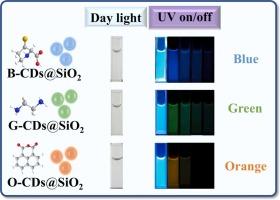Engineering strategy for achieving transparent aqueous multicolor long lifetime room temperature phosphorescent carbon dots
IF 17.1
1区 材料科学
Q1 CHEMISTRY, PHYSICAL
引用次数: 0
Abstract
Carbon dot-based room-temperature phosphorescent (RTP) materials are attracting more and more attention due to the exceptional optical properties. However, achieving stable afterglow emission in aqueous solution is a great challenge since high concentrations of dissolved oxygen in water severely quench triplet excitons. In this work, we report a multiple confinement structure strategy to realize multicolor tunable (blue to orange) and transparent aqueous phosphorescent carbon dots (CDs) for the first time. This approach synergistically restricts molecular motion of CDs through surface coordination and confinement within a three-dimensional nanosilica network, effectively suppressing nonradiative transitions. At the same time, phosphorescence emission can be amplified by tailored modification of abundant functional groups on surface of CDs. Thus, carbon dot-based silica nanocomposites (CDs@SiO2) not only exhibit high transparency (> 95%) and a long lifetime (1.5 s) in aqueous solution, but also have the ability to maintain a stable afterglow emission in harsh environments. Based on the advantages, novel multimodal anti-counterfeiting technologies, including Morse code and QR code encryption systems have been developed. This work proposes an engineering strategy for achieving multicolor transparent aqueous afterglow of CDs, laying a foundation for emerging applications in optical encryption and intelligent sensing.

实现透明水性多色长寿命室温磷光碳点的工程策略
碳点基室温磷光材料因其优异的光学性能而受到越来越多的关注。然而,在水溶液中实现稳定的余辉发射是一个巨大的挑战,因为水中高浓度的溶解氧会严重猝灭三重态激子。在这项工作中,我们首次报道了一种多重约束结构策略,以实现多色可调(蓝色到橙色)和透明的水性磷光碳点(cd)。这种方法通过在三维纳米二氧化硅网络中的表面配位和约束协同限制CDs的分子运动,有效地抑制非辐射跃迁。同时,通过对CDs表面丰富的官能团进行修饰,可以放大其磷光发射。因此,碳点基二氧化硅纳米复合材料(CDs@SiO2)不仅在水溶液中具有高透明度(> 95%)和长寿命(1.5 s),而且在恶劣环境中也能保持稳定的余辉发射。基于这些优点,人们开发了新型的多模态防伪技术,包括莫尔斯电码和QR码加密系统。本工作提出了一种实现多色透明cd水余辉的工程策略,为在光学加密和智能传感领域的新兴应用奠定了基础。
本文章由计算机程序翻译,如有差异,请以英文原文为准。
求助全文
约1分钟内获得全文
求助全文
来源期刊

Nano Energy
CHEMISTRY, PHYSICAL-NANOSCIENCE & NANOTECHNOLOGY
CiteScore
30.30
自引率
7.40%
发文量
1207
审稿时长
23 days
期刊介绍:
Nano Energy is a multidisciplinary, rapid-publication forum of original peer-reviewed contributions on the science and engineering of nanomaterials and nanodevices used in all forms of energy harvesting, conversion, storage, utilization and policy. Through its mixture of articles, reviews, communications, research news, and information on key developments, Nano Energy provides a comprehensive coverage of this exciting and dynamic field which joins nanoscience and nanotechnology with energy science. The journal is relevant to all those who are interested in nanomaterials solutions to the energy problem.
Nano Energy publishes original experimental and theoretical research on all aspects of energy-related research which utilizes nanomaterials and nanotechnology. Manuscripts of four types are considered: review articles which inform readers of the latest research and advances in energy science; rapid communications which feature exciting research breakthroughs in the field; full-length articles which report comprehensive research developments; and news and opinions which comment on topical issues or express views on the developments in related fields.
 求助内容:
求助内容: 应助结果提醒方式:
应助结果提醒方式:


